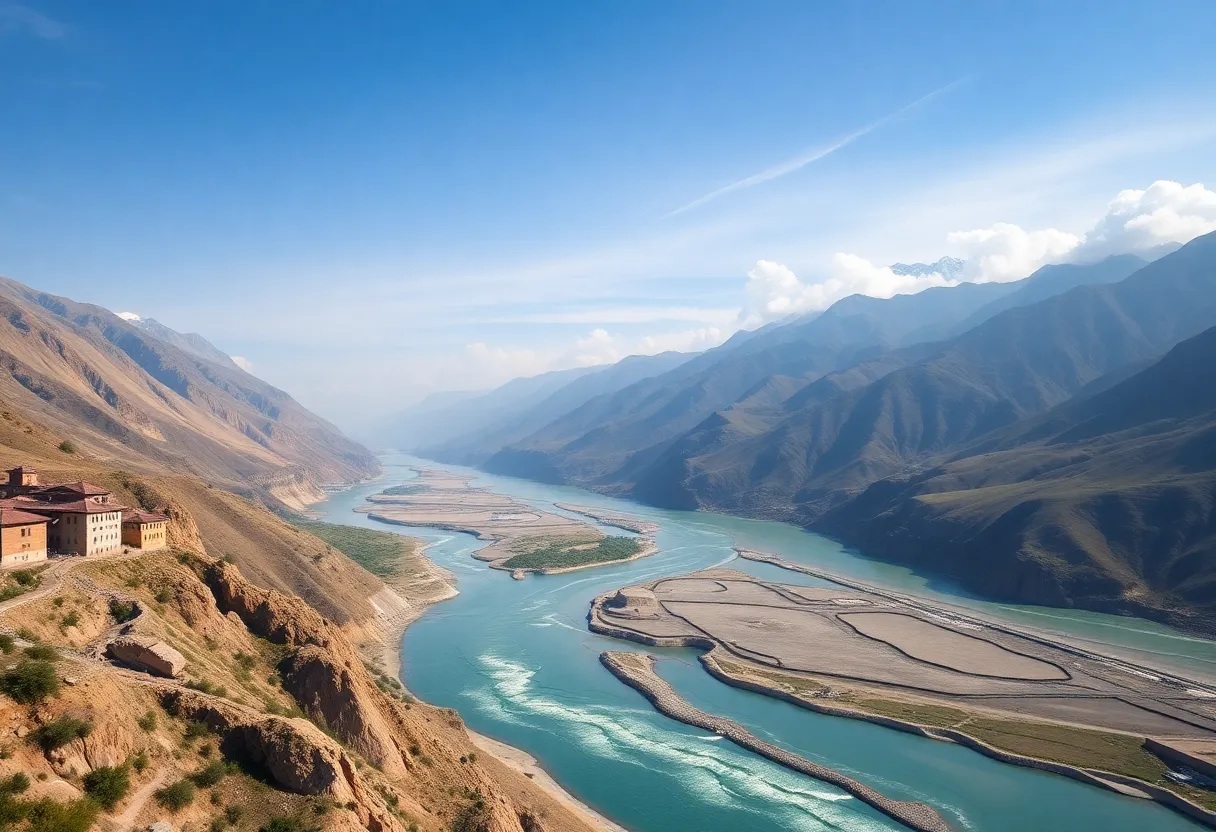News Summary
China has officially launched construction on a monumental dam along the Yarlung Zangbo River in Tibet, expected to become the largest hydroelectric power generator globally. With an estimated cost of 1.2 trillion yuan, the project aims to generate 300 billion kilowatt-hours of electricity annually, significantly contributing to China’s carbon neutrality goals. However, the project raises concerns for India regarding impacts on downstream ecosystems and local communities amidst a backdrop of historical tensions over territorial disputes in the region.
Beijing — China has officially commenced construction on a monumental dam along the Yarlung Zangbo River in Tibet, a project that is anticipated to become the world’s largest hydroelectric power generator. The Yarlung Zangbo, also known as the Brahmaputra River in India and the Jamuna River in Bangladesh, is a crucial water source for millions of people and plays a vital role in the ecology of the Tibetan Plateau.
The dam project, which includes the development of five hydropower stations, was kick-started with a commencement ceremony attended by Premier Li Qiang, as reported by China’s Xinhua state news agency. Planning for the dam has been ongoing for several years, with governmental approval granted in December of the previous year.
With an estimated cost of 1.2 trillion yuan (approximately $167.1 billion), the dam is a significant part of China’s strategy to meet its carbon neutrality ambitions while simultaneously fulfilling economic objectives in the Tibet region. Once completed, it is expected to generate an impressive 300 billion kilowatt-hours of electricity annually, primarily catering to the energy needs of regions beyond Tibet while also addressing local requirements.
As construction gets underway, India has expressed apprehensions regarding the dam’s potential impact on downstream ecosystems and communities. In January, Indian authorities emphasized the necessity of monitoring the situation to safeguard the interests of states reliant on the Brahmaputra River, urging China to ensure that its operations do not adversely affect them. Conversely, China’s Ministry of Foreign Affairs has reassured that the project will not negatively impact downstream areas and that ongoing communication with neighboring countries will be prioritized.
China’s intentions to construct the dam come amid historical tensions, particularly following the annexation of Tibet in 1950. This annexation has led to the establishment of multiple dams in the region, raising environmental concerns about irreversible harm to the ecosystems of the Tibetan Plateau, which serves as a critical water source for approximately 1.3 billion people across ten nations. Environmental groups, such as the International Campaign for Tibet, have voiced their opposition, stressing possible disruptions to both local and downstream communities.
The Yarlung Tsangpo, the world’s highest river, cascades from elevations nearing 5,000 meters (16,404 feet) above sea level and is regarded as sacred by the Tibetan people. The new dam is located just 30 kilometers (18 miles) from the border with India, an area rife with territorial disputes, adding another layer of complexity to the project.
If successful, the dam could produce up to three times the electricity generated by the controversial Three Gorges Dam on the Yangtze River, which has been noted for displacing about 1.4 million individuals. In contrast, previous hydropower projects in Tibet, such as the Yagen Hydropower Station in 2015, displaced around 2,000 people, indicating a relatively lower impact on local communities.
The dramatic drop in elevation along the Yarlung Zangbo contributes significantly to its hydropower potential, with a descent of 6,561 feet over a short distance enhancing its capacity for energy generation. In recent years, China has already initiated hydropower generation on the upper reaches of the Yarlung Zangbo, paving the way for this ambitious new project.
In summary, the construction of the mega-dam on the Yarlung Zangbo River marks a pivotal moment in China’s push for renewable energy development and economic growth in Tibet. As the project progresses, it raises important questions about environmental sustainability and regional diplomacy, especially in the context of China and India’s relationship concerning water resources and territorial issues.
Deeper Dive: News & Info About This Topic
HERE Resources
Additional Resources
- Al Jazeera
- Wikipedia: Yarlung Zangbo River
- NBC News
- Google Search: China hydropower dam Tibet
- Bloomberg
- Google Scholar: China hydropower dam Tibet
- Reuters
- Encyclopedia Britannica: Hydropower
Author: STAFF HERE LOS ANGELES WRITER
The LOS ANGELES STAFF WRITER represents the experienced team at HERELosAngeles.com, your go-to source for actionable local news and information in Los Angeles, Los Angeles County, and beyond, specializing in "news you can use" with coverage of product reviews for personal and business needs, local business directories, politics, real estate trends, neighborhood insights, and state news affecting the area—with deep expertise from years of dedicated reporting and strong community input, including local press releases and business updates, while delivering top reporting on high-value events like the Academy Awards, LA Auto Show, and Los Angeles Marathon, extending coverage to key organizations such as the Los Angeles Area Chamber of Commerce and the Los Angeles Tourism & Convention Board, plus leading businesses in entertainment and technology like Warner Bros. and SpaceX, and as part of the broader HERE network including HEREAnaheim.com , HERECostaMesa.com , HEREHuntingtonBeach.com , and HERESantaAna.com , providing comprehensive, credible insights into Southern California's dynamic landscape. HERE Anaheim HERE Beverly Hills HERE Coronado HERE Costa Mesa HERE Hollywood HERE Huntington Beach HERE Long Beach HERE Los Angeles HERE Mission Viejo HERE San Diego HERE Santa Ana





